Auditing Report: Auditing of Sydney Airport, Finance Module
VerifiedAdded on 2020/04/07
|29
|5027
|87
Report
AI Summary
This report presents a comprehensive auditing analysis of Sydney Airport, a major international airport in Australia. It begins with an executive summary and table of contents, followed by an introduction that sets the scope of the report. The report analyzes various aspects of the airport, including its nature, business operations, investment and financing activities, and financial reporting practices. It delves into the industry, regulatory, and external factors influencing the airport, such as industry size, growth, supply chain, major players, market share, critical success factors, and potential threats, along with legal and environmental considerations. The report includes a SWOT analysis and Porter's Five Forces analysis to assess the airport's strategic position and competitive landscape. Furthermore, it examines the airport's objectives, strategies, and business risks, including industry developments, new products and services, and regulatory requirements. The report also evaluates the airport's performance through analytical procedures, such as current ratio, debt-equity ratio, return on equity, and profit margin ratio. It also considers the impact of external factors and assesses management and governance aspects, including communication, commitment to competence, and organizational structure. The conclusion summarizes key findings and references relevant sources, along with an appendix featuring financial statements.
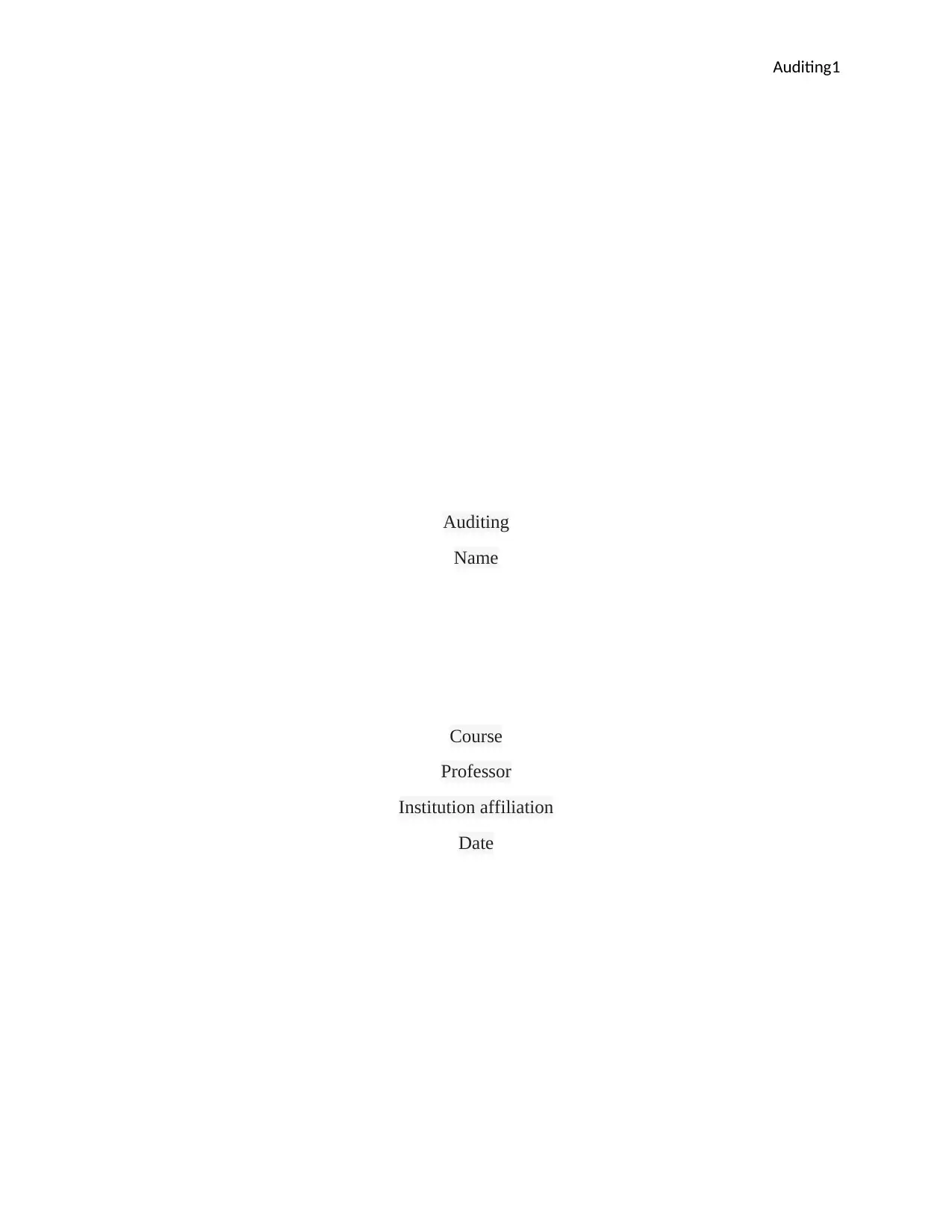
Auditing1
Auditing
Name
Course
Professor
Institution affiliation
Date
Auditing
Name
Course
Professor
Institution affiliation
Date
Paraphrase This Document
Need a fresh take? Get an instant paraphrase of this document with our AI Paraphraser
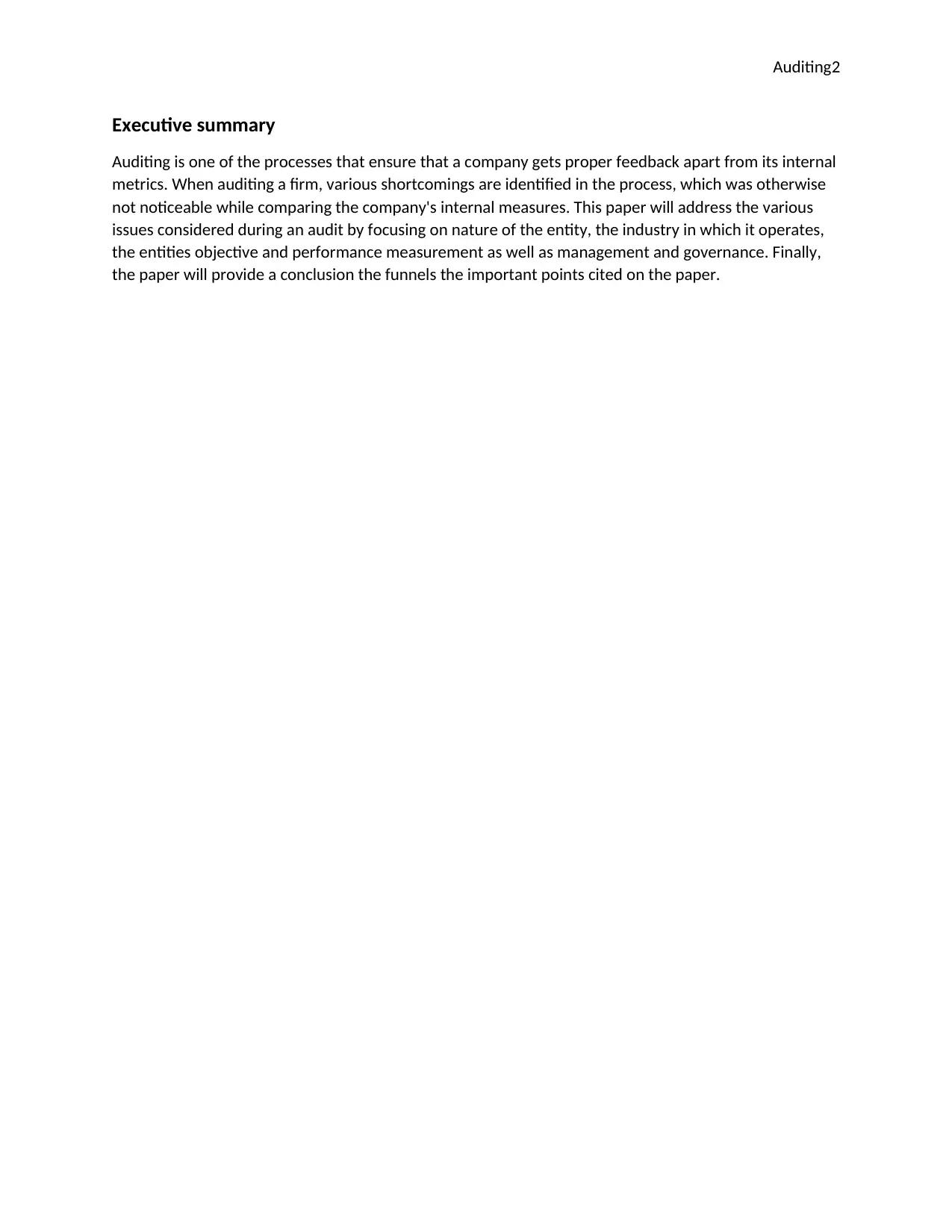
Auditing2
Executive summary
Auditing is one of the processes that ensure that a company gets proper feedback apart from its internal
metrics. When auditing a firm, various shortcomings are identified in the process, which was otherwise
not noticeable while comparing the company's internal measures. This paper will address the various
issues considered during an audit by focusing on nature of the entity, the industry in which it operates,
the entities objective and performance measurement as well as management and governance. Finally,
the paper will provide a conclusion the funnels the important points cited on the paper.
Executive summary
Auditing is one of the processes that ensure that a company gets proper feedback apart from its internal
metrics. When auditing a firm, various shortcomings are identified in the process, which was otherwise
not noticeable while comparing the company's internal measures. This paper will address the various
issues considered during an audit by focusing on nature of the entity, the industry in which it operates,
the entities objective and performance measurement as well as management and governance. Finally,
the paper will provide a conclusion the funnels the important points cited on the paper.
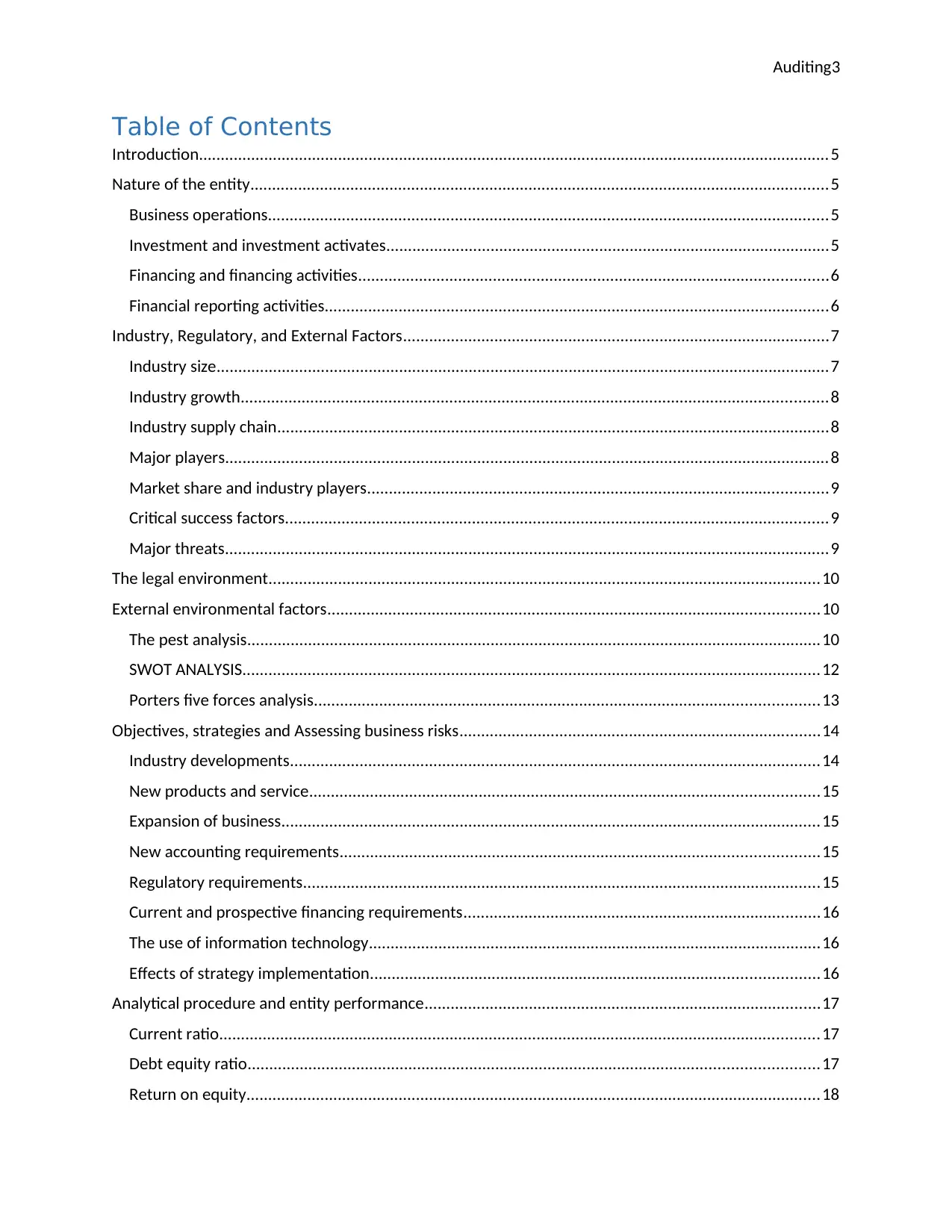
Auditing3
Table of Contents
Introduction.................................................................................................................................................5
Nature of the entity.....................................................................................................................................5
Business operations.................................................................................................................................5
Investment and investment activates......................................................................................................5
Financing and financing activities............................................................................................................6
Financial reporting activities....................................................................................................................6
Industry, Regulatory, and External Factors..................................................................................................7
Industry size.............................................................................................................................................7
Industry growth.......................................................................................................................................8
Industry supply chain...............................................................................................................................8
Major players...........................................................................................................................................8
Market share and industry players..........................................................................................................9
Critical success factors.............................................................................................................................9
Major threats...........................................................................................................................................9
The legal environment...............................................................................................................................10
External environmental factors.................................................................................................................10
The pest analysis....................................................................................................................................10
SWOT ANALYSIS.....................................................................................................................................12
Porters five forces analysis....................................................................................................................13
Objectives, strategies and Assessing business risks...................................................................................14
Industry developments..........................................................................................................................14
New products and service.....................................................................................................................15
Expansion of business............................................................................................................................15
New accounting requirements..............................................................................................................15
Regulatory requirements.......................................................................................................................15
Current and prospective financing requirements..................................................................................16
The use of information technology........................................................................................................16
Effects of strategy implementation.......................................................................................................16
Analytical procedure and entity performance...........................................................................................17
Current ratio..........................................................................................................................................17
Debt equity ratio...................................................................................................................................17
Return on equity....................................................................................................................................18
Table of Contents
Introduction.................................................................................................................................................5
Nature of the entity.....................................................................................................................................5
Business operations.................................................................................................................................5
Investment and investment activates......................................................................................................5
Financing and financing activities............................................................................................................6
Financial reporting activities....................................................................................................................6
Industry, Regulatory, and External Factors..................................................................................................7
Industry size.............................................................................................................................................7
Industry growth.......................................................................................................................................8
Industry supply chain...............................................................................................................................8
Major players...........................................................................................................................................8
Market share and industry players..........................................................................................................9
Critical success factors.............................................................................................................................9
Major threats...........................................................................................................................................9
The legal environment...............................................................................................................................10
External environmental factors.................................................................................................................10
The pest analysis....................................................................................................................................10
SWOT ANALYSIS.....................................................................................................................................12
Porters five forces analysis....................................................................................................................13
Objectives, strategies and Assessing business risks...................................................................................14
Industry developments..........................................................................................................................14
New products and service.....................................................................................................................15
Expansion of business............................................................................................................................15
New accounting requirements..............................................................................................................15
Regulatory requirements.......................................................................................................................15
Current and prospective financing requirements..................................................................................16
The use of information technology........................................................................................................16
Effects of strategy implementation.......................................................................................................16
Analytical procedure and entity performance...........................................................................................17
Current ratio..........................................................................................................................................17
Debt equity ratio...................................................................................................................................17
Return on equity....................................................................................................................................18
⊘ This is a preview!⊘
Do you want full access?
Subscribe today to unlock all pages.

Trusted by 1+ million students worldwide
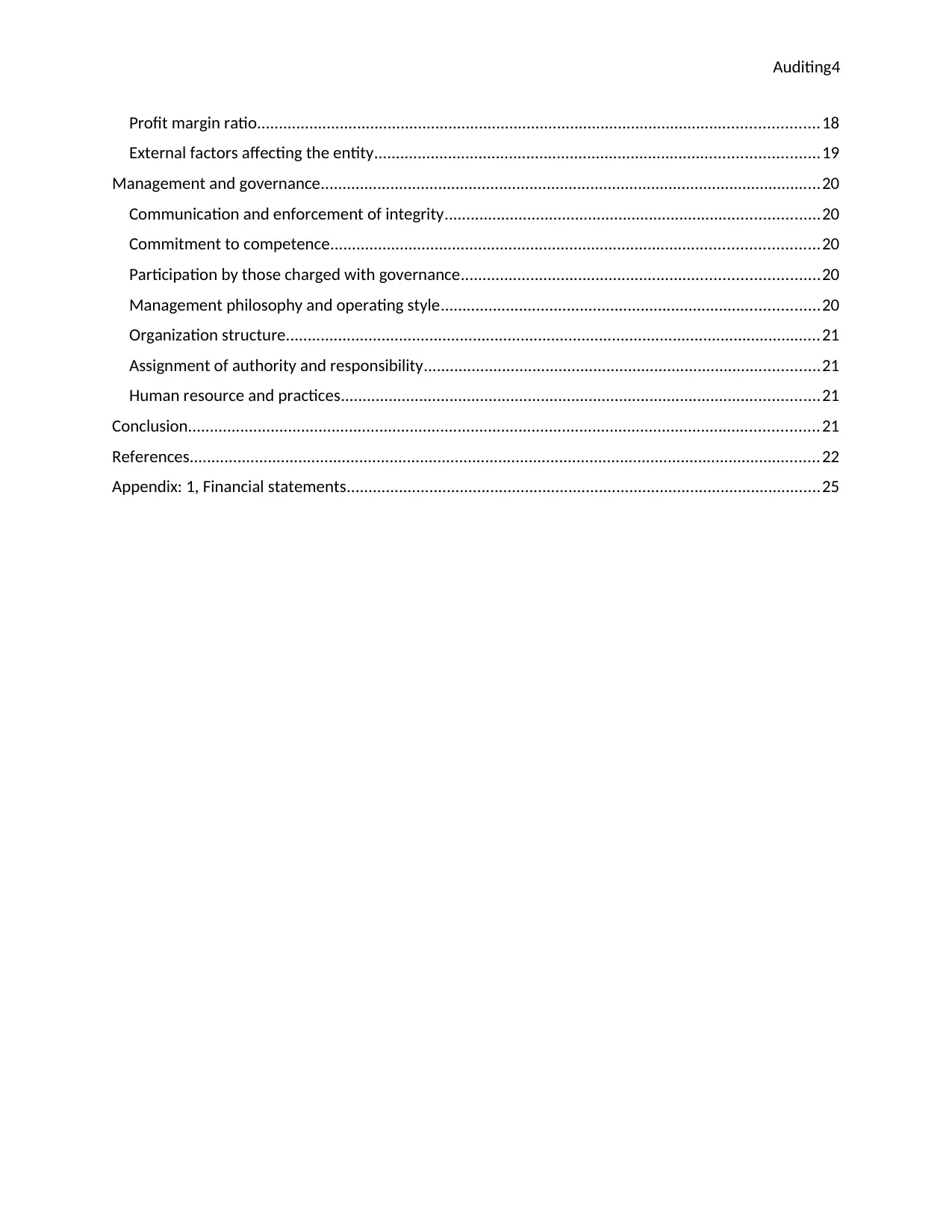
Auditing4
Profit margin ratio.................................................................................................................................18
External factors affecting the entity......................................................................................................19
Management and governance...................................................................................................................20
Communication and enforcement of integrity......................................................................................20
Commitment to competence................................................................................................................20
Participation by those charged with governance..................................................................................20
Management philosophy and operating style.......................................................................................20
Organization structure...........................................................................................................................21
Assignment of authority and responsibility...........................................................................................21
Human resource and practices..............................................................................................................21
Conclusion.................................................................................................................................................21
References.................................................................................................................................................22
Appendix: 1, Financial statements.............................................................................................................25
Profit margin ratio.................................................................................................................................18
External factors affecting the entity......................................................................................................19
Management and governance...................................................................................................................20
Communication and enforcement of integrity......................................................................................20
Commitment to competence................................................................................................................20
Participation by those charged with governance..................................................................................20
Management philosophy and operating style.......................................................................................20
Organization structure...........................................................................................................................21
Assignment of authority and responsibility...........................................................................................21
Human resource and practices..............................................................................................................21
Conclusion.................................................................................................................................................21
References.................................................................................................................................................22
Appendix: 1, Financial statements.............................................................................................................25
Paraphrase This Document
Need a fresh take? Get an instant paraphrase of this document with our AI Paraphraser
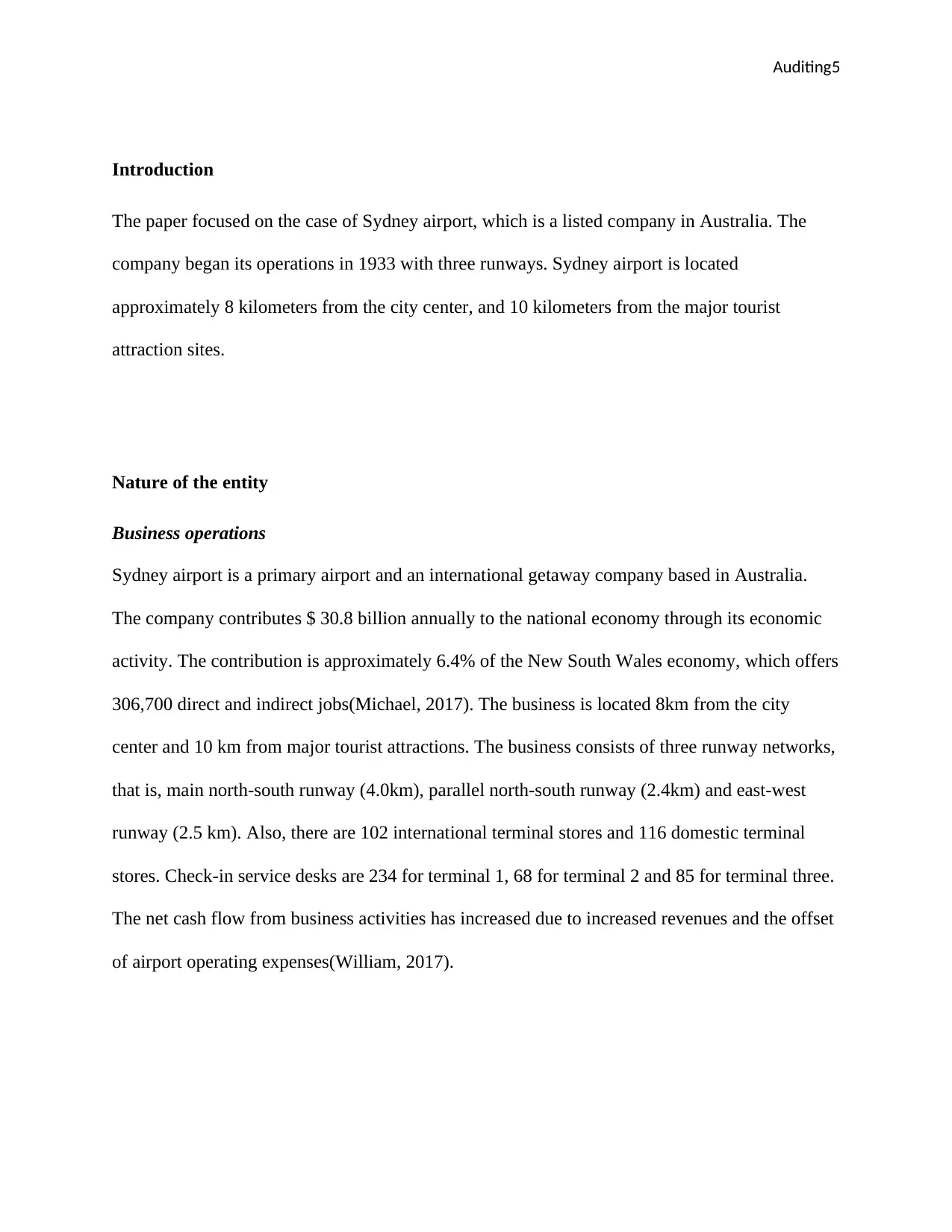
Auditing5
Introduction
The paper focused on the case of Sydney airport, which is a listed company in Australia. The
company began its operations in 1933 with three runways. Sydney airport is located
approximately 8 kilometers from the city center, and 10 kilometers from the major tourist
attraction sites.
Nature of the entity
Business operations
Sydney airport is a primary airport and an international getaway company based in Australia.
The company contributes $ 30.8 billion annually to the national economy through its economic
activity. The contribution is approximately 6.4% of the New South Wales economy, which offers
306,700 direct and indirect jobs(Michael, 2017). The business is located 8km from the city
center and 10 km from major tourist attractions. The business consists of three runway networks,
that is, main north-south runway (4.0km), parallel north-south runway (2.4km) and east-west
runway (2.5 km). Also, there are 102 international terminal stores and 116 domestic terminal
stores. Check-in service desks are 234 for terminal 1, 68 for terminal 2 and 85 for terminal three.
The net cash flow from business activities has increased due to increased revenues and the offset
of airport operating expenses(William, 2017).
Introduction
The paper focused on the case of Sydney airport, which is a listed company in Australia. The
company began its operations in 1933 with three runways. Sydney airport is located
approximately 8 kilometers from the city center, and 10 kilometers from the major tourist
attraction sites.
Nature of the entity
Business operations
Sydney airport is a primary airport and an international getaway company based in Australia.
The company contributes $ 30.8 billion annually to the national economy through its economic
activity. The contribution is approximately 6.4% of the New South Wales economy, which offers
306,700 direct and indirect jobs(Michael, 2017). The business is located 8km from the city
center and 10 km from major tourist attractions. The business consists of three runway networks,
that is, main north-south runway (4.0km), parallel north-south runway (2.4km) and east-west
runway (2.5 km). Also, there are 102 international terminal stores and 116 domestic terminal
stores. Check-in service desks are 234 for terminal 1, 68 for terminal 2 and 85 for terminal three.
The net cash flow from business activities has increased due to increased revenues and the offset
of airport operating expenses(William, 2017).
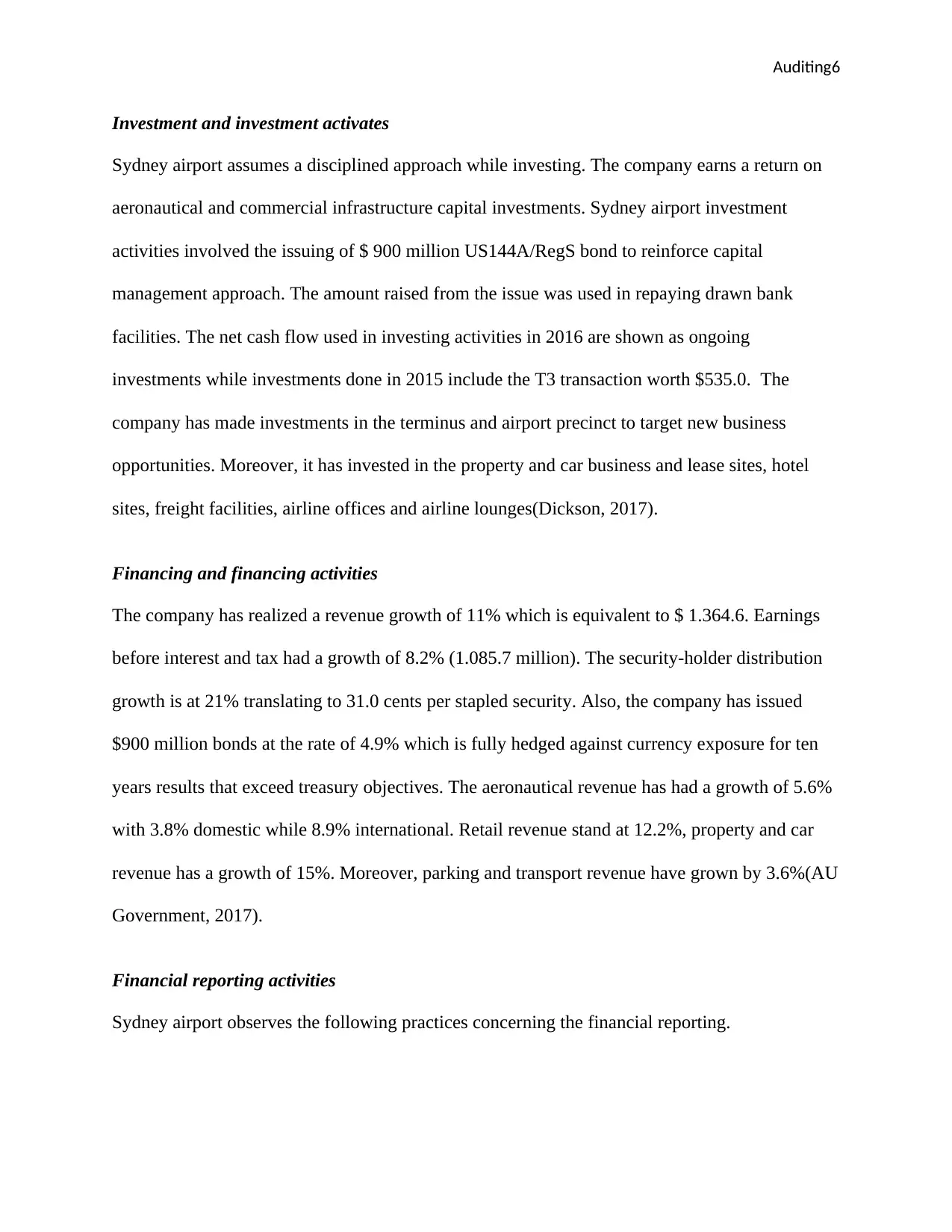
Auditing6
Investment and investment activates
Sydney airport assumes a disciplined approach while investing. The company earns a return on
aeronautical and commercial infrastructure capital investments. Sydney airport investment
activities involved the issuing of $ 900 million US144A/RegS bond to reinforce capital
management approach. The amount raised from the issue was used in repaying drawn bank
facilities. The net cash flow used in investing activities in 2016 are shown as ongoing
investments while investments done in 2015 include the T3 transaction worth $535.0. The
company has made investments in the terminus and airport precinct to target new business
opportunities. Moreover, it has invested in the property and car business and lease sites, hotel
sites, freight facilities, airline offices and airline lounges(Dickson, 2017).
Financing and financing activities
The company has realized a revenue growth of 11% which is equivalent to $ 1.364.6. Earnings
before interest and tax had a growth of 8.2% (1.085.7 million). The security-holder distribution
growth is at 21% translating to 31.0 cents per stapled security. Also, the company has issued
$900 million bonds at the rate of 4.9% which is fully hedged against currency exposure for ten
years results that exceed treasury objectives. The aeronautical revenue has had a growth of 5.6%
with 3.8% domestic while 8.9% international. Retail revenue stand at 12.2%, property and car
revenue has a growth of 15%. Moreover, parking and transport revenue have grown by 3.6%(AU
Government, 2017).
Financial reporting activities
Sydney airport observes the following practices concerning the financial reporting.
Investment and investment activates
Sydney airport assumes a disciplined approach while investing. The company earns a return on
aeronautical and commercial infrastructure capital investments. Sydney airport investment
activities involved the issuing of $ 900 million US144A/RegS bond to reinforce capital
management approach. The amount raised from the issue was used in repaying drawn bank
facilities. The net cash flow used in investing activities in 2016 are shown as ongoing
investments while investments done in 2015 include the T3 transaction worth $535.0. The
company has made investments in the terminus and airport precinct to target new business
opportunities. Moreover, it has invested in the property and car business and lease sites, hotel
sites, freight facilities, airline offices and airline lounges(Dickson, 2017).
Financing and financing activities
The company has realized a revenue growth of 11% which is equivalent to $ 1.364.6. Earnings
before interest and tax had a growth of 8.2% (1.085.7 million). The security-holder distribution
growth is at 21% translating to 31.0 cents per stapled security. Also, the company has issued
$900 million bonds at the rate of 4.9% which is fully hedged against currency exposure for ten
years results that exceed treasury objectives. The aeronautical revenue has had a growth of 5.6%
with 3.8% domestic while 8.9% international. Retail revenue stand at 12.2%, property and car
revenue has a growth of 15%. Moreover, parking and transport revenue have grown by 3.6%(AU
Government, 2017).
Financial reporting activities
Sydney airport observes the following practices concerning the financial reporting.
⊘ This is a preview!⊘
Do you want full access?
Subscribe today to unlock all pages.

Trusted by 1+ million students worldwide
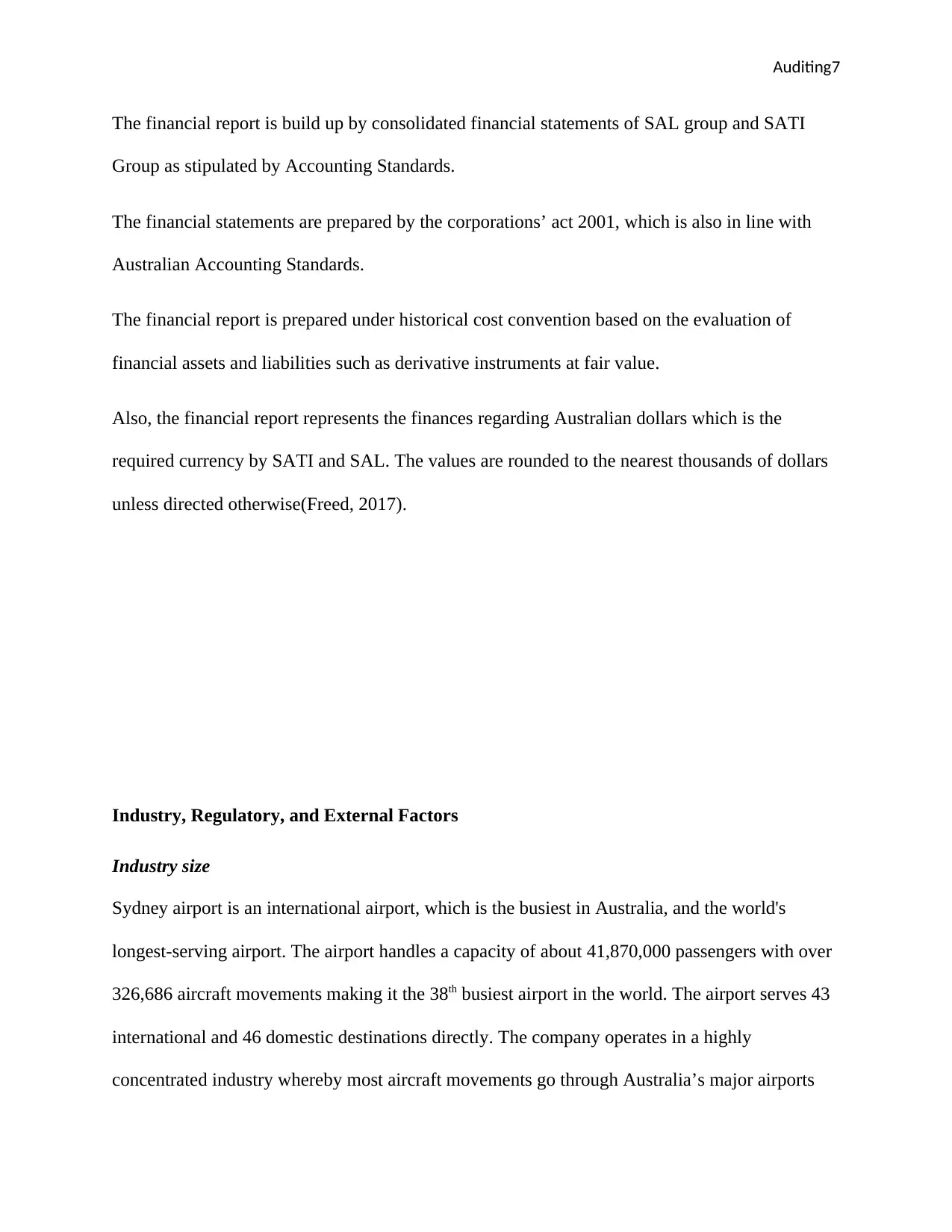
Auditing7
The financial report is build up by consolidated financial statements of SAL group and SATI
Group as stipulated by Accounting Standards.
The financial statements are prepared by the corporations’ act 2001, which is also in line with
Australian Accounting Standards.
The financial report is prepared under historical cost convention based on the evaluation of
financial assets and liabilities such as derivative instruments at fair value.
Also, the financial report represents the finances regarding Australian dollars which is the
required currency by SATI and SAL. The values are rounded to the nearest thousands of dollars
unless directed otherwise(Freed, 2017).
Industry, Regulatory, and External Factors
Industry size
Sydney airport is an international airport, which is the busiest in Australia, and the world's
longest-serving airport. The airport handles a capacity of about 41,870,000 passengers with over
326,686 aircraft movements making it the 38th busiest airport in the world. The airport serves 43
international and 46 domestic destinations directly. The company operates in a highly
concentrated industry whereby most aircraft movements go through Australia’s major airports
The financial report is build up by consolidated financial statements of SAL group and SATI
Group as stipulated by Accounting Standards.
The financial statements are prepared by the corporations’ act 2001, which is also in line with
Australian Accounting Standards.
The financial report is prepared under historical cost convention based on the evaluation of
financial assets and liabilities such as derivative instruments at fair value.
Also, the financial report represents the finances regarding Australian dollars which is the
required currency by SATI and SAL. The values are rounded to the nearest thousands of dollars
unless directed otherwise(Freed, 2017).
Industry, Regulatory, and External Factors
Industry size
Sydney airport is an international airport, which is the busiest in Australia, and the world's
longest-serving airport. The airport handles a capacity of about 41,870,000 passengers with over
326,686 aircraft movements making it the 38th busiest airport in the world. The airport serves 43
international and 46 domestic destinations directly. The company operates in a highly
concentrated industry whereby most aircraft movements go through Australia’s major airports
Paraphrase This Document
Need a fresh take? Get an instant paraphrase of this document with our AI Paraphraser
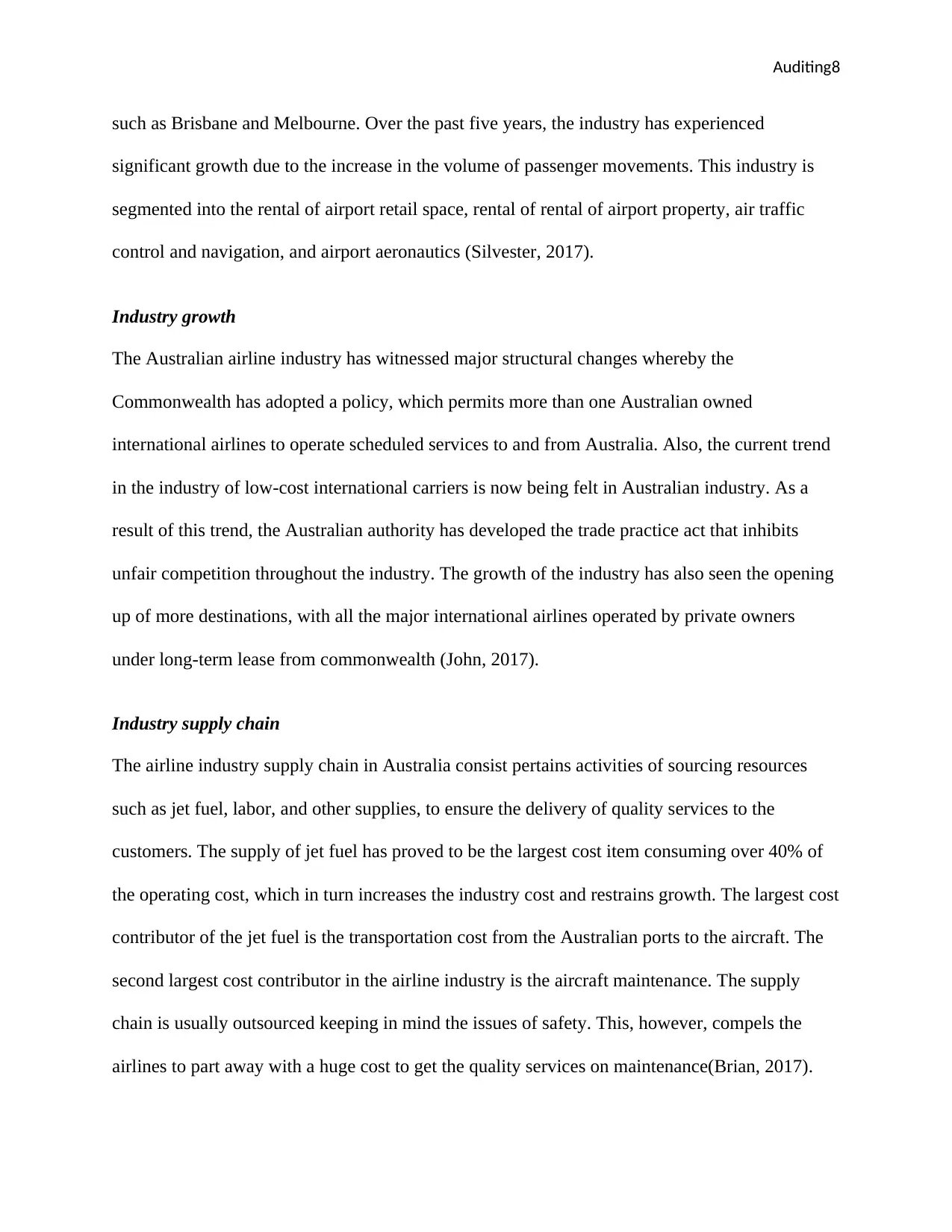
Auditing8
such as Brisbane and Melbourne. Over the past five years, the industry has experienced
significant growth due to the increase in the volume of passenger movements. This industry is
segmented into the rental of airport retail space, rental of rental of airport property, air traffic
control and navigation, and airport aeronautics (Silvester, 2017).
Industry growth
The Australian airline industry has witnessed major structural changes whereby the
Commonwealth has adopted a policy, which permits more than one Australian owned
international airlines to operate scheduled services to and from Australia. Also, the current trend
in the industry of low-cost international carriers is now being felt in Australian industry. As a
result of this trend, the Australian authority has developed the trade practice act that inhibits
unfair competition throughout the industry. The growth of the industry has also seen the opening
up of more destinations, with all the major international airlines operated by private owners
under long-term lease from commonwealth (John, 2017).
Industry supply chain
The airline industry supply chain in Australia consist pertains activities of sourcing resources
such as jet fuel, labor, and other supplies, to ensure the delivery of quality services to the
customers. The supply of jet fuel has proved to be the largest cost item consuming over 40% of
the operating cost, which in turn increases the industry cost and restrains growth. The largest cost
contributor of the jet fuel is the transportation cost from the Australian ports to the aircraft. The
second largest cost contributor in the airline industry is the aircraft maintenance. The supply
chain is usually outsourced keeping in mind the issues of safety. This, however, compels the
airlines to part away with a huge cost to get the quality services on maintenance(Brian, 2017).
such as Brisbane and Melbourne. Over the past five years, the industry has experienced
significant growth due to the increase in the volume of passenger movements. This industry is
segmented into the rental of airport retail space, rental of rental of airport property, air traffic
control and navigation, and airport aeronautics (Silvester, 2017).
Industry growth
The Australian airline industry has witnessed major structural changes whereby the
Commonwealth has adopted a policy, which permits more than one Australian owned
international airlines to operate scheduled services to and from Australia. Also, the current trend
in the industry of low-cost international carriers is now being felt in Australian industry. As a
result of this trend, the Australian authority has developed the trade practice act that inhibits
unfair competition throughout the industry. The growth of the industry has also seen the opening
up of more destinations, with all the major international airlines operated by private owners
under long-term lease from commonwealth (John, 2017).
Industry supply chain
The airline industry supply chain in Australia consist pertains activities of sourcing resources
such as jet fuel, labor, and other supplies, to ensure the delivery of quality services to the
customers. The supply of jet fuel has proved to be the largest cost item consuming over 40% of
the operating cost, which in turn increases the industry cost and restrains growth. The largest cost
contributor of the jet fuel is the transportation cost from the Australian ports to the aircraft. The
second largest cost contributor in the airline industry is the aircraft maintenance. The supply
chain is usually outsourced keeping in mind the issues of safety. This, however, compels the
airlines to part away with a huge cost to get the quality services on maintenance(Brian, 2017).
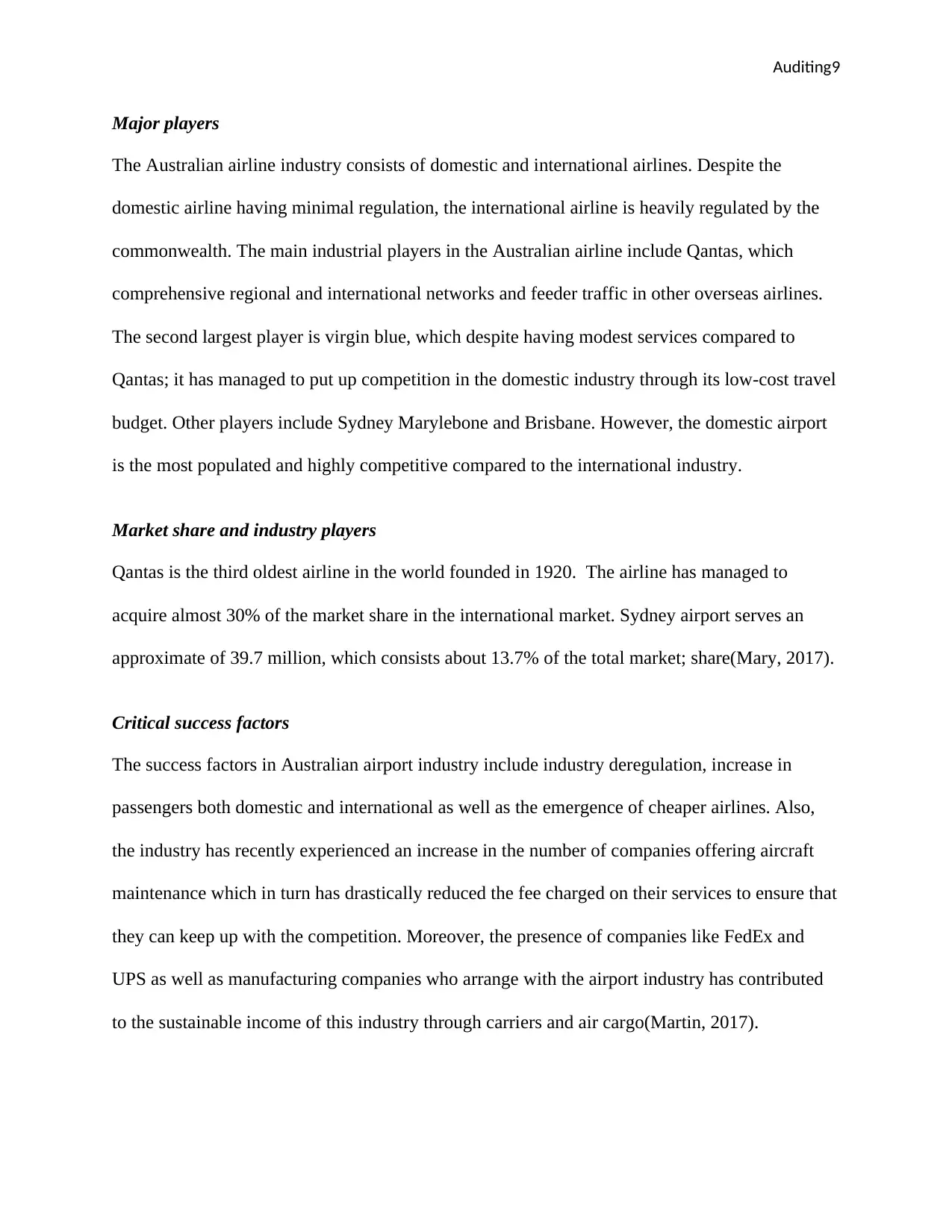
Auditing9
Major players
The Australian airline industry consists of domestic and international airlines. Despite the
domestic airline having minimal regulation, the international airline is heavily regulated by the
commonwealth. The main industrial players in the Australian airline include Qantas, which
comprehensive regional and international networks and feeder traffic in other overseas airlines.
The second largest player is virgin blue, which despite having modest services compared to
Qantas; it has managed to put up competition in the domestic industry through its low-cost travel
budget. Other players include Sydney Marylebone and Brisbane. However, the domestic airport
is the most populated and highly competitive compared to the international industry.
Market share and industry players
Qantas is the third oldest airline in the world founded in 1920. The airline has managed to
acquire almost 30% of the market share in the international market. Sydney airport serves an
approximate of 39.7 million, which consists about 13.7% of the total market; share(Mary, 2017).
Critical success factors
The success factors in Australian airport industry include industry deregulation, increase in
passengers both domestic and international as well as the emergence of cheaper airlines. Also,
the industry has recently experienced an increase in the number of companies offering aircraft
maintenance which in turn has drastically reduced the fee charged on their services to ensure that
they can keep up with the competition. Moreover, the presence of companies like FedEx and
UPS as well as manufacturing companies who arrange with the airport industry has contributed
to the sustainable income of this industry through carriers and air cargo(Martin, 2017).
Major players
The Australian airline industry consists of domestic and international airlines. Despite the
domestic airline having minimal regulation, the international airline is heavily regulated by the
commonwealth. The main industrial players in the Australian airline include Qantas, which
comprehensive regional and international networks and feeder traffic in other overseas airlines.
The second largest player is virgin blue, which despite having modest services compared to
Qantas; it has managed to put up competition in the domestic industry through its low-cost travel
budget. Other players include Sydney Marylebone and Brisbane. However, the domestic airport
is the most populated and highly competitive compared to the international industry.
Market share and industry players
Qantas is the third oldest airline in the world founded in 1920. The airline has managed to
acquire almost 30% of the market share in the international market. Sydney airport serves an
approximate of 39.7 million, which consists about 13.7% of the total market; share(Mary, 2017).
Critical success factors
The success factors in Australian airport industry include industry deregulation, increase in
passengers both domestic and international as well as the emergence of cheaper airlines. Also,
the industry has recently experienced an increase in the number of companies offering aircraft
maintenance which in turn has drastically reduced the fee charged on their services to ensure that
they can keep up with the competition. Moreover, the presence of companies like FedEx and
UPS as well as manufacturing companies who arrange with the airport industry has contributed
to the sustainable income of this industry through carriers and air cargo(Martin, 2017).
⊘ This is a preview!⊘
Do you want full access?
Subscribe today to unlock all pages.

Trusted by 1+ million students worldwide
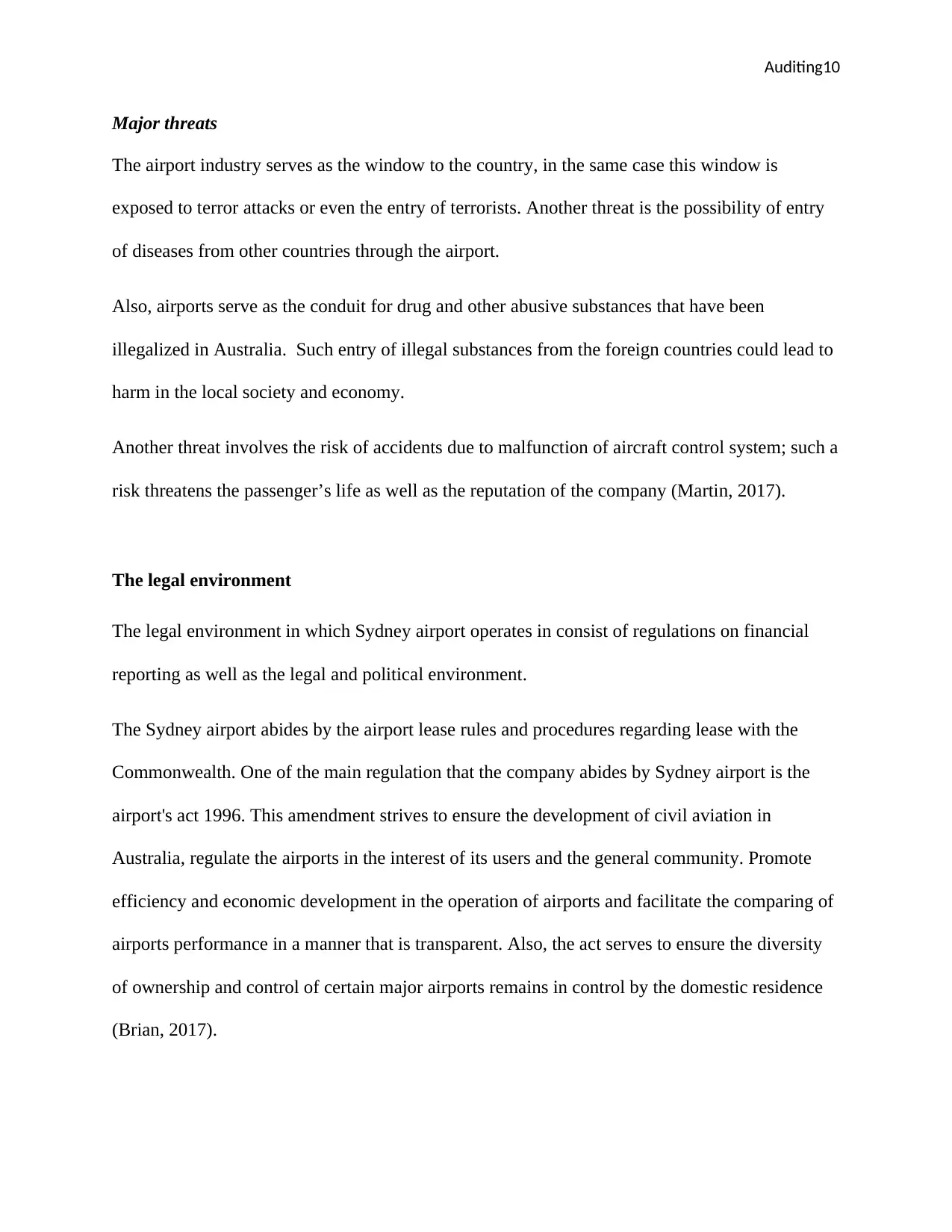
Auditing10
Major threats
The airport industry serves as the window to the country, in the same case this window is
exposed to terror attacks or even the entry of terrorists. Another threat is the possibility of entry
of diseases from other countries through the airport.
Also, airports serve as the conduit for drug and other abusive substances that have been
illegalized in Australia. Such entry of illegal substances from the foreign countries could lead to
harm in the local society and economy.
Another threat involves the risk of accidents due to malfunction of aircraft control system; such a
risk threatens the passenger’s life as well as the reputation of the company (Martin, 2017).
The legal environment
The legal environment in which Sydney airport operates in consist of regulations on financial
reporting as well as the legal and political environment.
The Sydney airport abides by the airport lease rules and procedures regarding lease with the
Commonwealth. One of the main regulation that the company abides by Sydney airport is the
airport's act 1996. This amendment strives to ensure the development of civil aviation in
Australia, regulate the airports in the interest of its users and the general community. Promote
efficiency and economic development in the operation of airports and facilitate the comparing of
airports performance in a manner that is transparent. Also, the act serves to ensure the diversity
of ownership and control of certain major airports remains in control by the domestic residence
(Brian, 2017).
Major threats
The airport industry serves as the window to the country, in the same case this window is
exposed to terror attacks or even the entry of terrorists. Another threat is the possibility of entry
of diseases from other countries through the airport.
Also, airports serve as the conduit for drug and other abusive substances that have been
illegalized in Australia. Such entry of illegal substances from the foreign countries could lead to
harm in the local society and economy.
Another threat involves the risk of accidents due to malfunction of aircraft control system; such a
risk threatens the passenger’s life as well as the reputation of the company (Martin, 2017).
The legal environment
The legal environment in which Sydney airport operates in consist of regulations on financial
reporting as well as the legal and political environment.
The Sydney airport abides by the airport lease rules and procedures regarding lease with the
Commonwealth. One of the main regulation that the company abides by Sydney airport is the
airport's act 1996. This amendment strives to ensure the development of civil aviation in
Australia, regulate the airports in the interest of its users and the general community. Promote
efficiency and economic development in the operation of airports and facilitate the comparing of
airports performance in a manner that is transparent. Also, the act serves to ensure the diversity
of ownership and control of certain major airports remains in control by the domestic residence
(Brian, 2017).
Paraphrase This Document
Need a fresh take? Get an instant paraphrase of this document with our AI Paraphraser
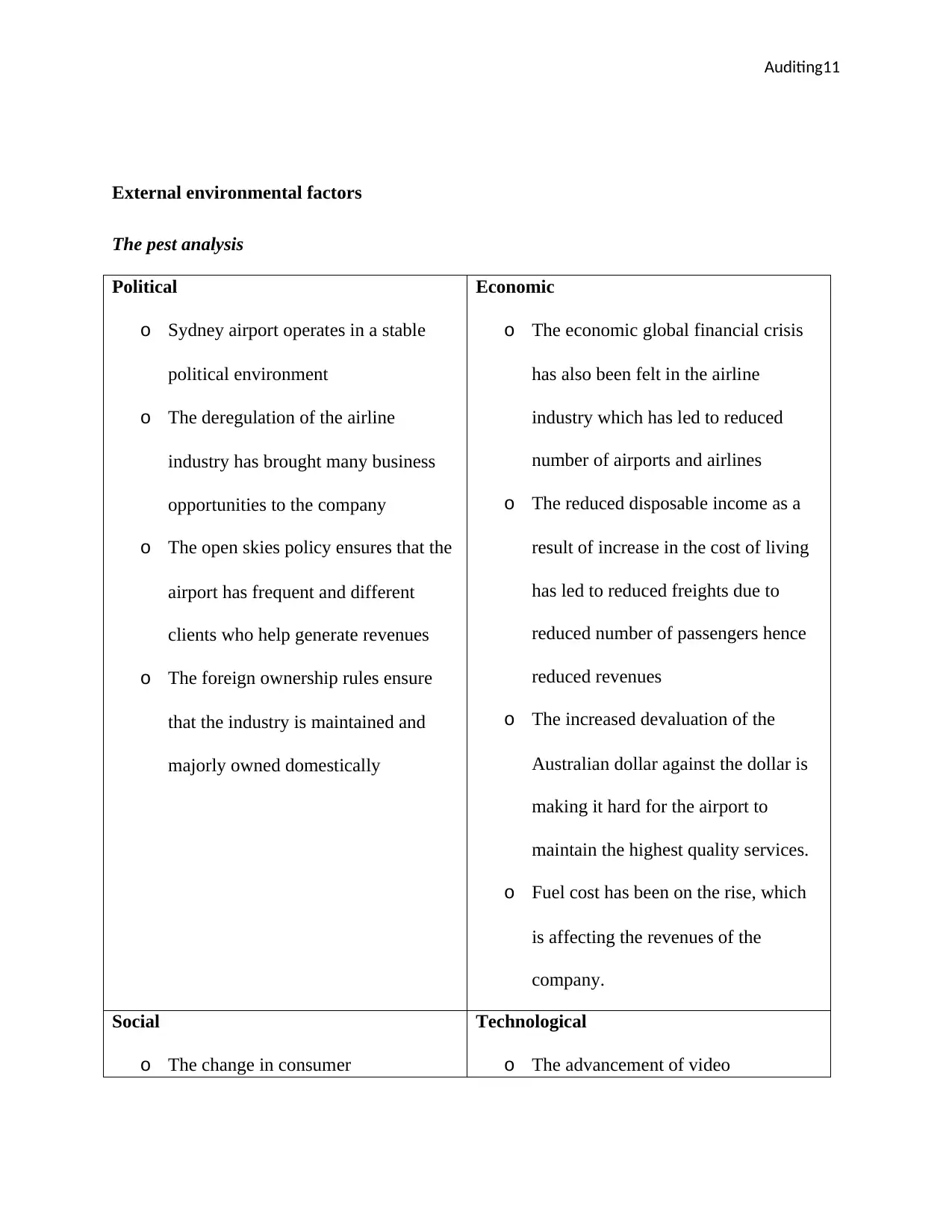
Auditing11
External environmental factors
The pest analysis
Political
o Sydney airport operates in a stable
political environment
o The deregulation of the airline
industry has brought many business
opportunities to the company
o The open skies policy ensures that the
airport has frequent and different
clients who help generate revenues
o The foreign ownership rules ensure
that the industry is maintained and
majorly owned domestically
Economic
o The economic global financial crisis
has also been felt in the airline
industry which has led to reduced
number of airports and airlines
o The reduced disposable income as a
result of increase in the cost of living
has led to reduced freights due to
reduced number of passengers hence
reduced revenues
o The increased devaluation of the
Australian dollar against the dollar is
making it hard for the airport to
maintain the highest quality services.
o Fuel cost has been on the rise, which
is affecting the revenues of the
company.
Social
o The change in consumer
Technological
o The advancement of video
External environmental factors
The pest analysis
Political
o Sydney airport operates in a stable
political environment
o The deregulation of the airline
industry has brought many business
opportunities to the company
o The open skies policy ensures that the
airport has frequent and different
clients who help generate revenues
o The foreign ownership rules ensure
that the industry is maintained and
majorly owned domestically
Economic
o The economic global financial crisis
has also been felt in the airline
industry which has led to reduced
number of airports and airlines
o The reduced disposable income as a
result of increase in the cost of living
has led to reduced freights due to
reduced number of passengers hence
reduced revenues
o The increased devaluation of the
Australian dollar against the dollar is
making it hard for the airport to
maintain the highest quality services.
o Fuel cost has been on the rise, which
is affecting the revenues of the
company.
Social
o The change in consumer
Technological
o The advancement of video
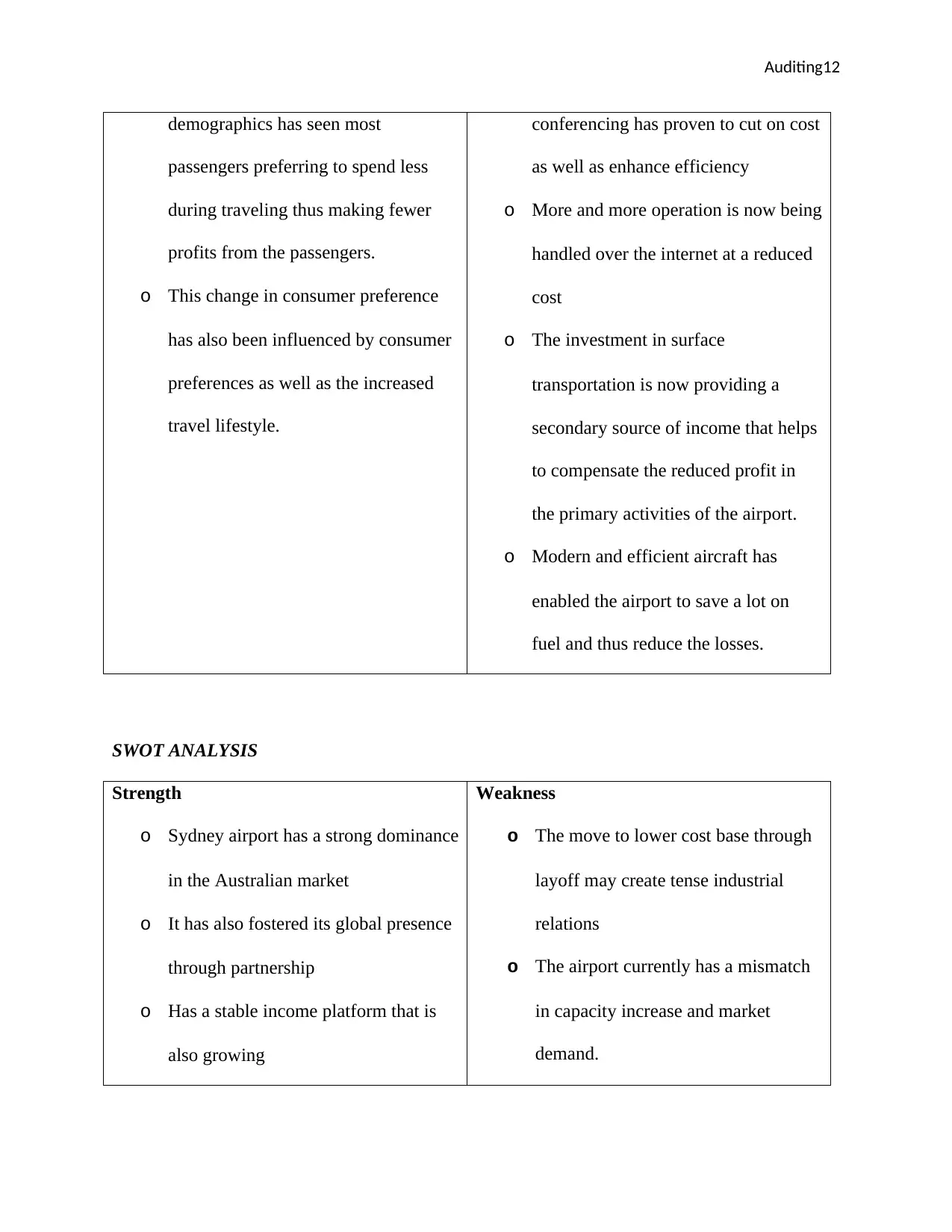
Auditing12
demographics has seen most
passengers preferring to spend less
during traveling thus making fewer
profits from the passengers.
o This change in consumer preference
has also been influenced by consumer
preferences as well as the increased
travel lifestyle.
conferencing has proven to cut on cost
as well as enhance efficiency
o More and more operation is now being
handled over the internet at a reduced
cost
o The investment in surface
transportation is now providing a
secondary source of income that helps
to compensate the reduced profit in
the primary activities of the airport.
o Modern and efficient aircraft has
enabled the airport to save a lot on
fuel and thus reduce the losses.
SWOT ANALYSIS
Strength
o Sydney airport has a strong dominance
in the Australian market
o It has also fostered its global presence
through partnership
o Has a stable income platform that is
also growing
Weakness
o The move to lower cost base through
layoff may create tense industrial
relations
o The airport currently has a mismatch
in capacity increase and market
demand.
demographics has seen most
passengers preferring to spend less
during traveling thus making fewer
profits from the passengers.
o This change in consumer preference
has also been influenced by consumer
preferences as well as the increased
travel lifestyle.
conferencing has proven to cut on cost
as well as enhance efficiency
o More and more operation is now being
handled over the internet at a reduced
cost
o The investment in surface
transportation is now providing a
secondary source of income that helps
to compensate the reduced profit in
the primary activities of the airport.
o Modern and efficient aircraft has
enabled the airport to save a lot on
fuel and thus reduce the losses.
SWOT ANALYSIS
Strength
o Sydney airport has a strong dominance
in the Australian market
o It has also fostered its global presence
through partnership
o Has a stable income platform that is
also growing
Weakness
o The move to lower cost base through
layoff may create tense industrial
relations
o The airport currently has a mismatch
in capacity increase and market
demand.
⊘ This is a preview!⊘
Do you want full access?
Subscribe today to unlock all pages.

Trusted by 1+ million students worldwide
1 out of 29
Related Documents
Your All-in-One AI-Powered Toolkit for Academic Success.
+13062052269
info@desklib.com
Available 24*7 on WhatsApp / Email
![[object Object]](/_next/static/media/star-bottom.7253800d.svg)
Unlock your academic potential
Copyright © 2020–2025 A2Z Services. All Rights Reserved. Developed and managed by ZUCOL.





